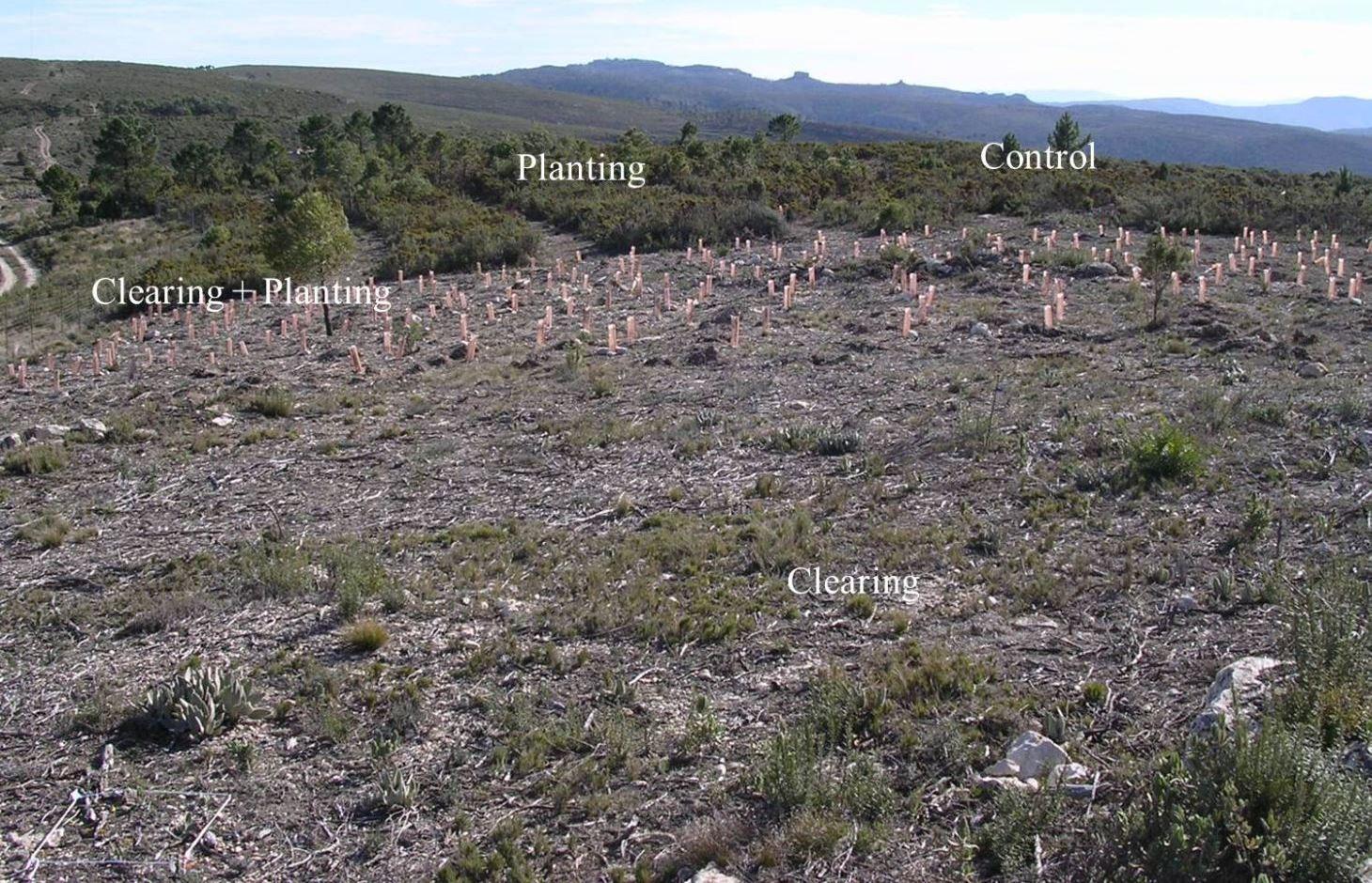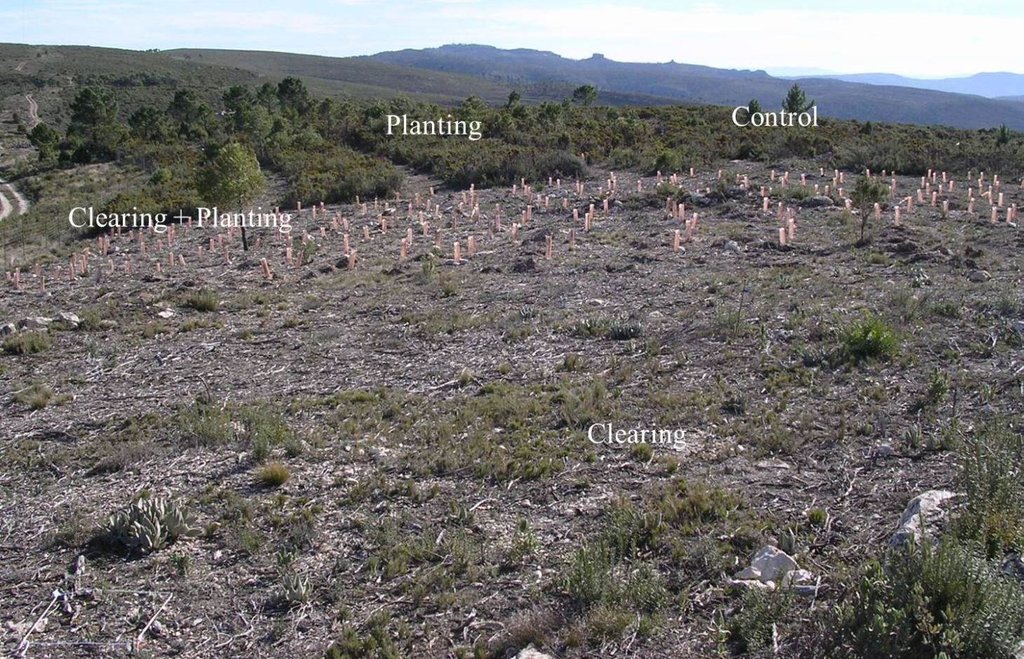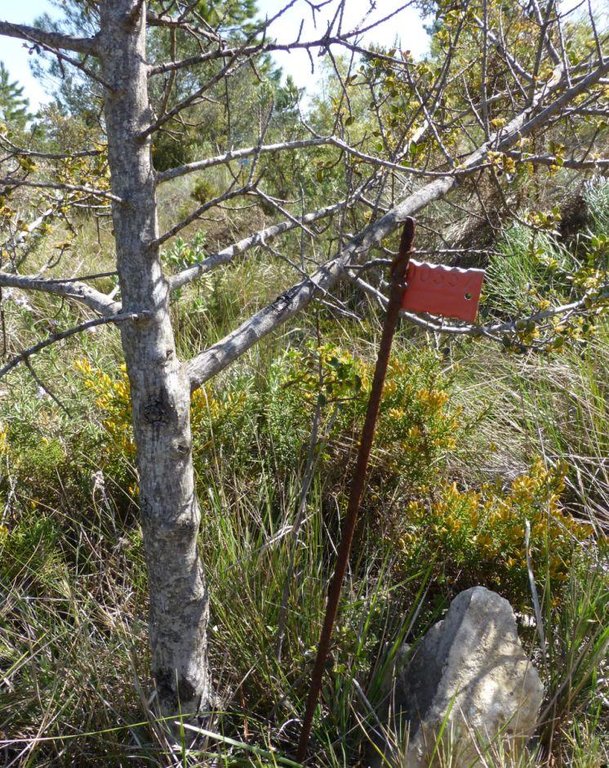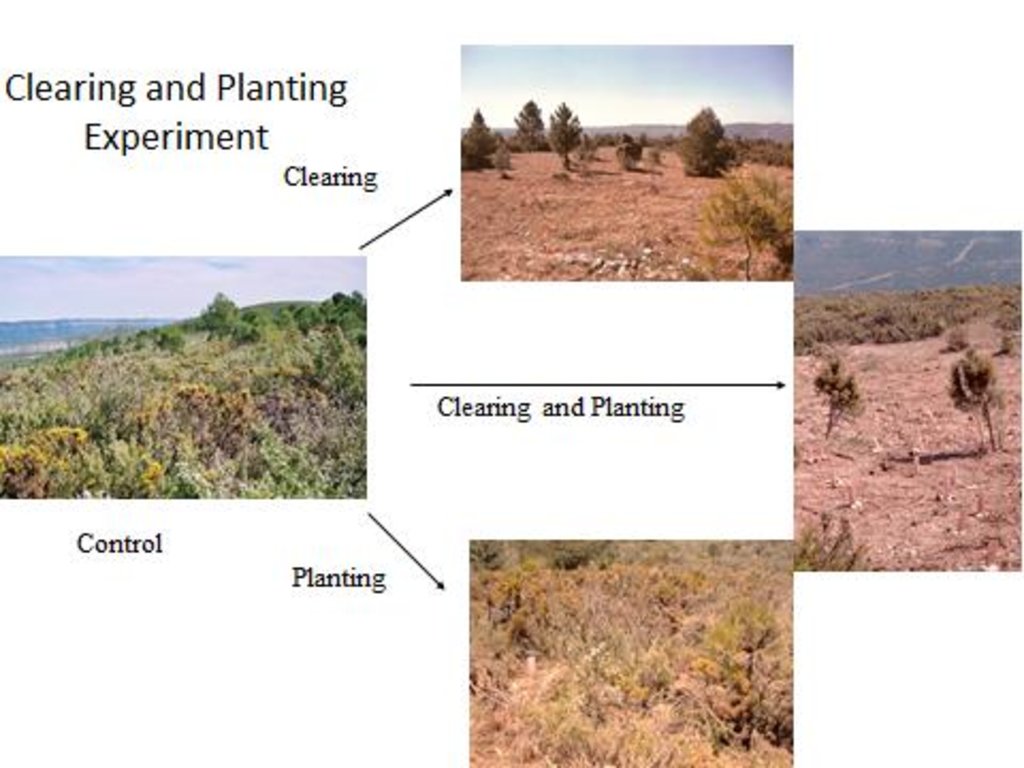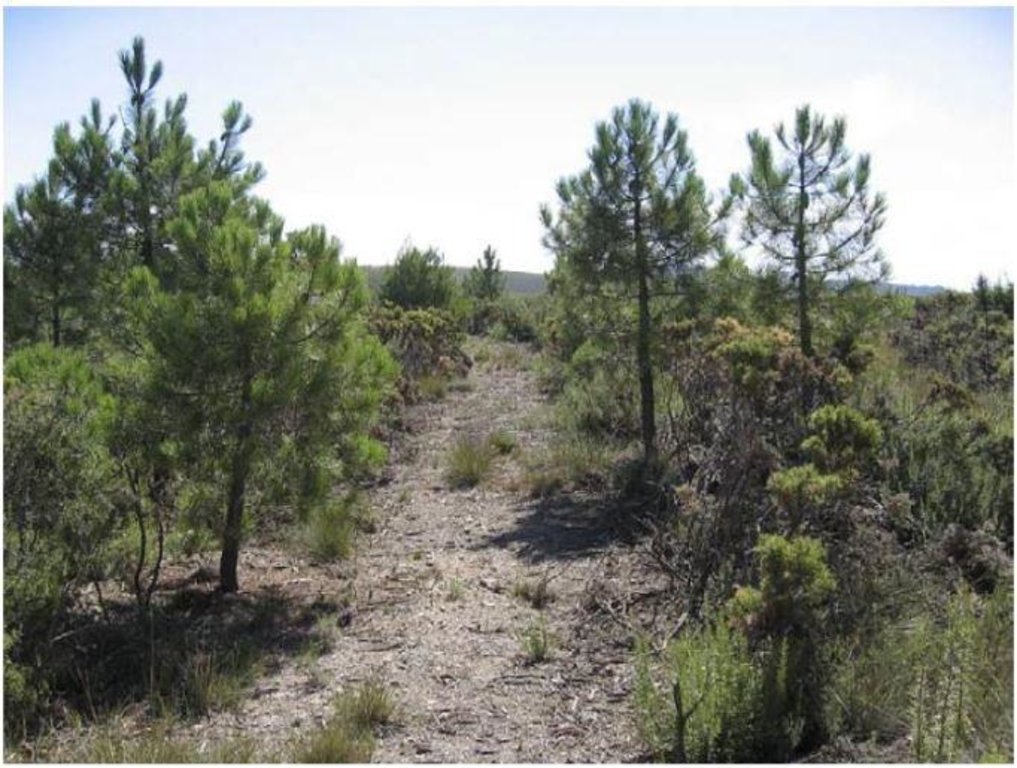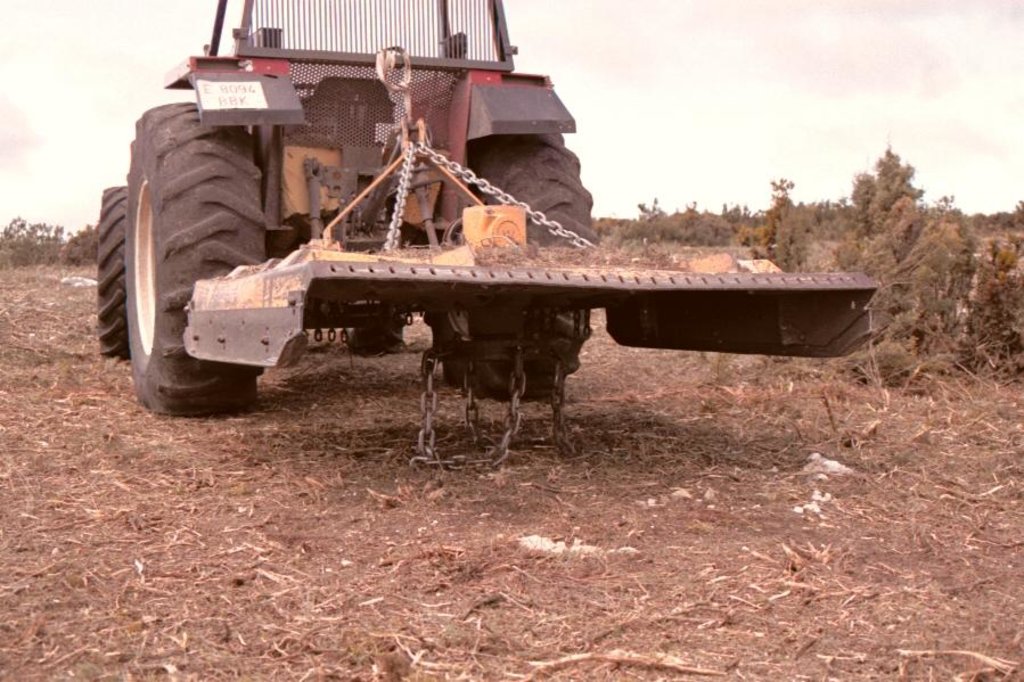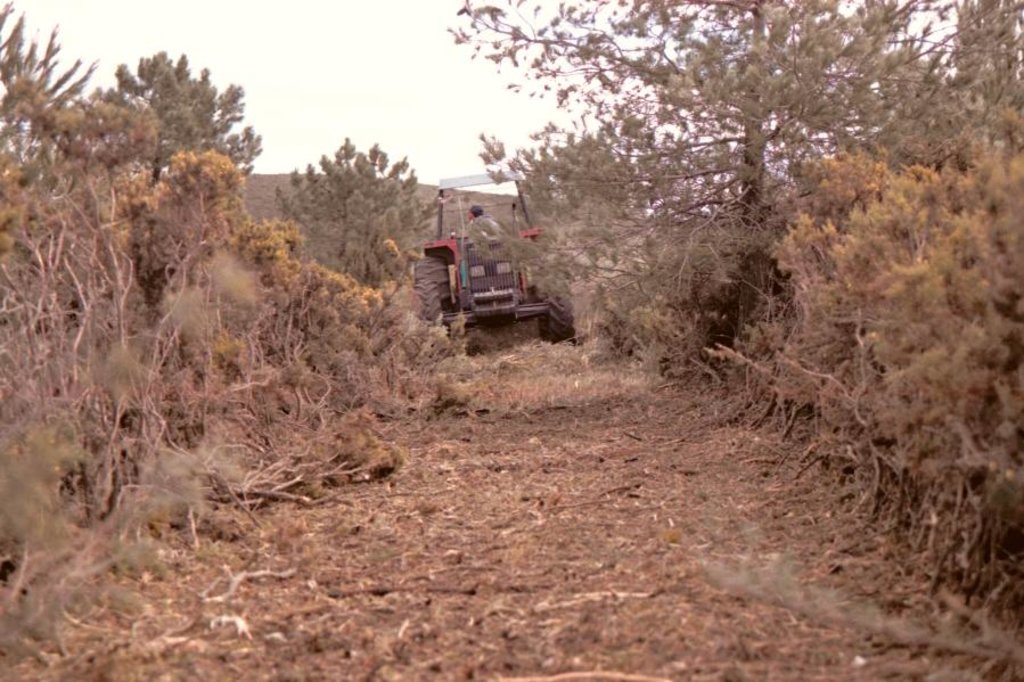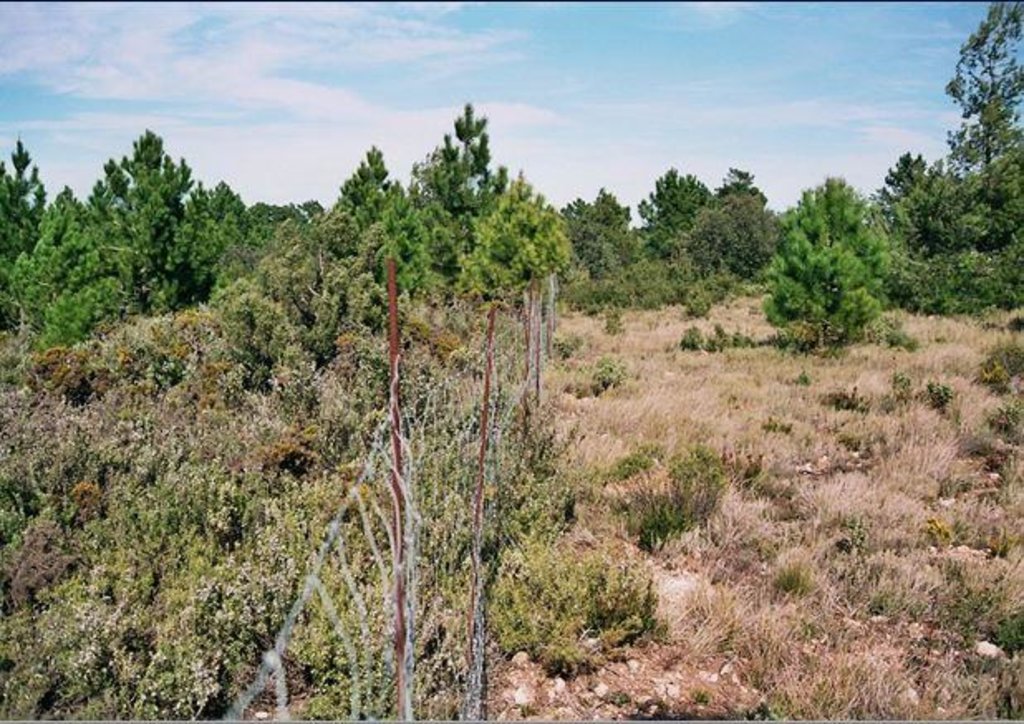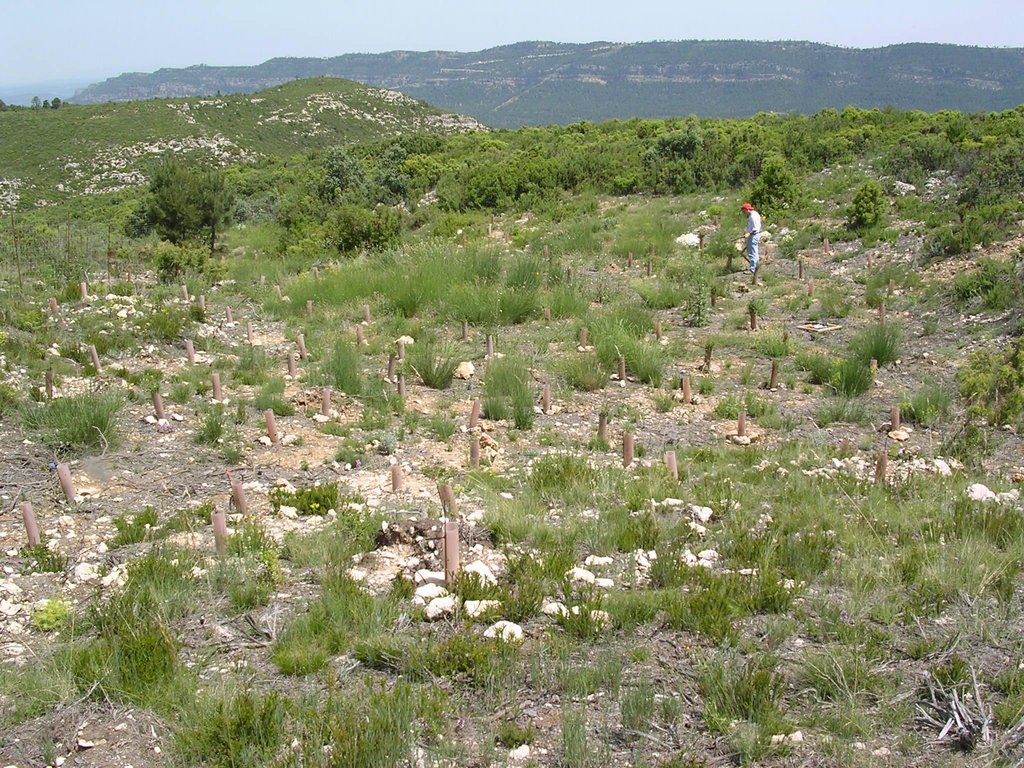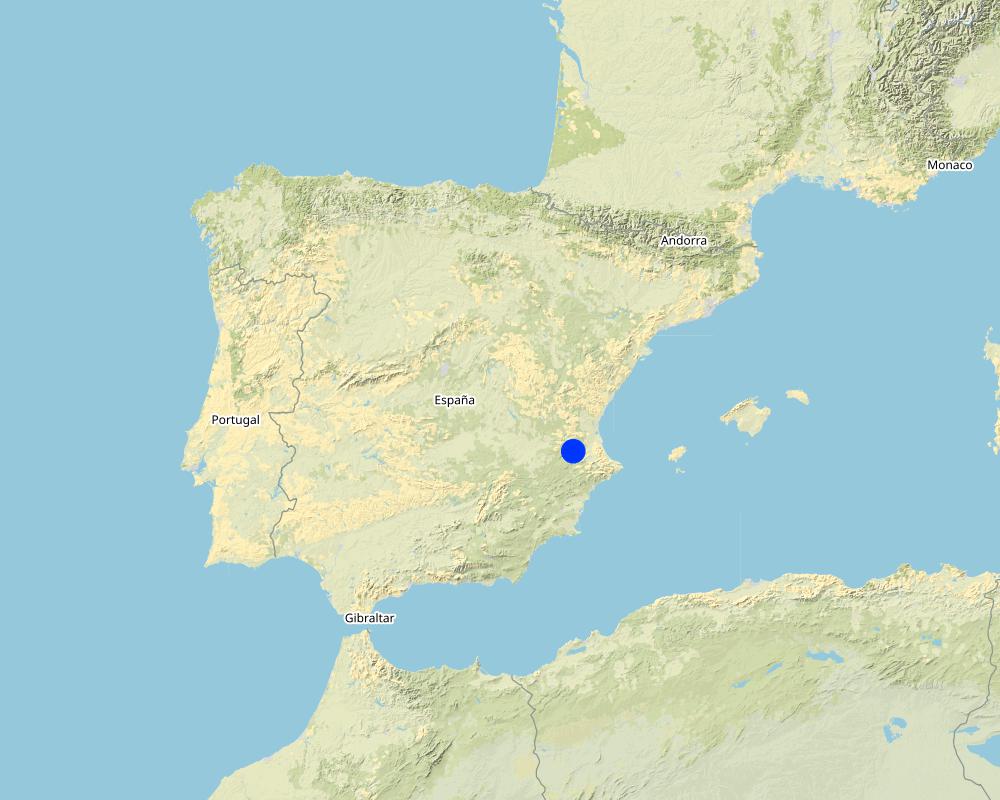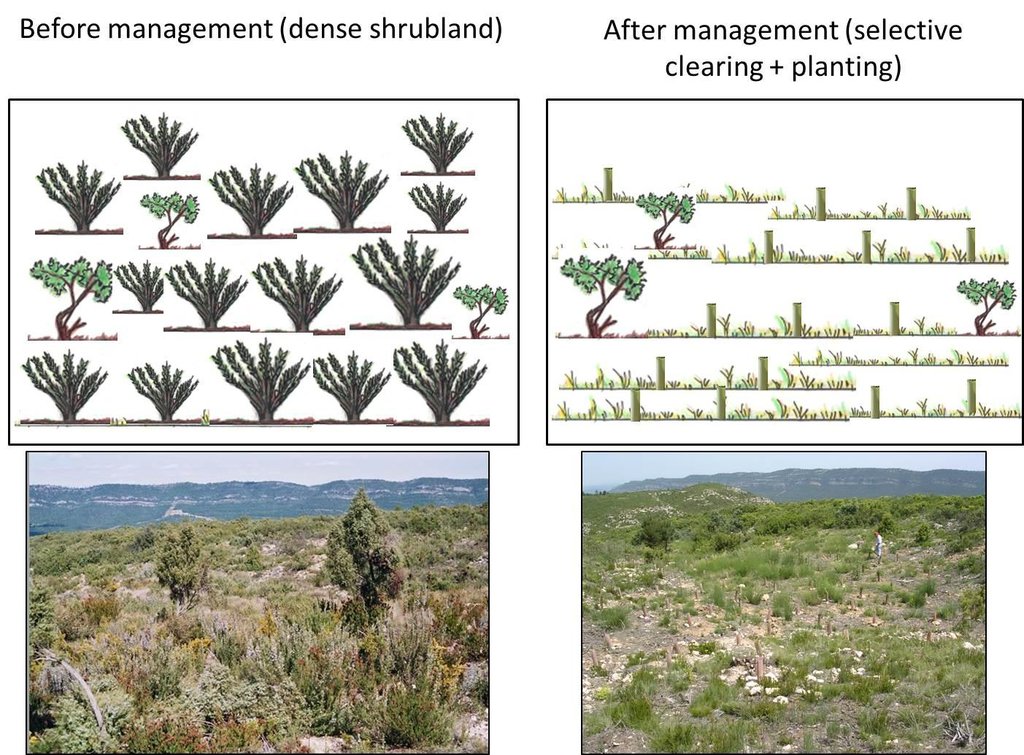Selective clearing and planting experiment to promote shrubland fire resilience [إسبانيا]
- تاريخ الإنشاء:
- تحديث:
- جامع المعلومات: Nina Lauterburg
- المحرر: –
- المراجعون: Alexandra Gavilano, Deborah Niggli, Hanspeter Liniger
Experimento para aumentar la resiliencia del matorral contra incendios (Spanish)
technologies_1579 - إسبانيا
- Selective clearing and planting experiment to promote shrubland fire resilience: 4 يناير، 2017 (inactive)
- Selective clearing and planting experiment to promote shrubland fire resilience: 30 يوليو، 2019 (inactive)
- Selective clearing and planting experiment to promote shrubland fire resilience: 1 ديسمبر، 2021 (public)
عرض الأقسام
توسيع الكل طي الكل1. معلومات عامة
1.2 تفاصيل الاتصال بالأشخاص الرئيسيين لمصدر المعلومات والمؤسسات المشاركة في تقييم وتوثيق التقنية
متخصص في الإدارة المستدامة للأراضي:
Valdecantos Alejandro
Fundación Centro de Estudios Ambientales del Mediterráneo (CEAM)
إسبانيا
متخصص في الإدارة المستدامة للأراضي:
Baeza Jaime
Fundación Centro de Estudios Ambientales del Mediterráneo (CEAM)
إسبانيا
اسم المشروع الذي سهّل توثيق/تقييم التقنية (إذا كان ذلك على صلة)
Catastrophic shifts in drylands (EU-CASCADE)اسم المؤسسة (المؤسسات) التي سهلت توثيق/تقييم التقنية (إذا كان ذلك على صلة)
Centro de Estudios Ambientales del Mediterraneo (CEAM) - إسبانيا1.3 الشروط المتعلقة باستخدام البيانات الموثقة من خلال WOCAT
يوافق جامع المعلومات والشخص (لاشخاص) الرئيسي لمصدر المعلومات على الشروط المتعلقة باستخدام البيانات الموثقة من خلال WOCAT:
نعم
1.4 إعلان بشأن استدامة التقنية الموصوفة
هل التقنية الموصوفة هنا تمثل مشكلة فيما يتعلق بتدهور الأراضي، بحيث لا يمكن إعلانها تقنية مستدامة لإدارة الأراضي؟:
كلا
2. وصف تقنيةالإدارة المستدامي للأراضي
2.1 وصف مختصر للتقنية
تعريف التقنية:
The combination of clearing of fire-prone seeder species and planting of more fire resistant resprouter species directs the vegetation to later successional stages which increases the resilience to fires.
2.2 وصف تفصيلي للتقنية
الوصف:
The forests and shrublands in Ayora experienced a series of disturbances in the past (such as deforestation and land use), which resulted in the degradation of the vegetation and the reduction of the resilience to fires. At present, there is a high fire incidence. Post-fire landscapes regenerated with a high and continuous fuel accumulation with few native resprouter species. Therefore appropriate vegetation management is crucial.
For management the major goals are to reduce the fuel load and its continuity and to increase the resilience of the vegetation to fires. Within this experiment carried out by CEAM (Centro de Estudios Ambientales del Mediterráneo, University of Valencia) different fuel management techniques were examined. They selected three study sites (Morera, Roñoso, Gachas) with a similar history of land use, vegetation composition, soil characteristics, and a typical post-fire scenario whith scarce occurrence of resprouter species. In each site, four plots were established to test the effect of the following management techniques: 1) control (no action), 2) clearing, 3) planting (within the shrubland) and 4) the combination of clearing and planting.
The main purpose of this experiment was to find out which management technique is the most appropriate to prevent fires and it was shown that the combination of selective clearing of fire-prone shrubs (fuel control) and planting of more resistant resprouter species can increase the resilience to fires and is therefore a suitable management practice. Compared to the other management techniques, there are some advantages. Clearing the vegetation (either by hand or mechanically) reduces the fire risk and enhances seedling establishment and growth. Furthermore, the cleared vegetation is chipped and applied in-situ as mulch, which protects the soil from erosion, reduces soil temperature and moisture loss, and enhances carbon conservation. Additionnally, selective clearing allows to preserve desired species and by planting resprouter species the natural processes can be accelerated. Once established, resprouter species persist for a long time which promotes an increase of the vegetation resilience.
In this documentation, only the combination of clearing and planting is evaluated since this action is considered as the most appropriate management practice.
In each study site, the experimental area covered about 5000m2 (3 plots of 1000m2 each, one plot of 2000m2). To test the effect of the combination of clearing and planting, a clearing machine was used to clear a plot of 1000 m2 in all three sites. The few resprouting individuals such as Juniperus oxycedrus and Quercus ilex and also some seeder trees such as Pinus halepensis and Pinus pinaster were left standing. The planting holes (0.35 m2) were created with a tractor using a backhoe. The slash and brush chips generated by the clearing were reused in the planting holes as mulch which resulted in ecological benefits.
In February 2003, native resprouters of late successional stages with a low amount of dead fuel were planted, such as Quercus ilex, Rhamnus alaternus and Pistacia lentiscus, all protected by a plastic tree shelter to prevent browsing.
The seedlings were grown for 8 months in a nursery in Santa Faz (Alicante) and then transferred to a nursery in La Hunde (Ayora) one month before planting. The Regional Forest Services of Valencia provided seeds as well.
The region of Ayora is mountainous with a dry subhumid climate (~380 mm annual rainfall). The risk of fire incidence is at its highest from June to September when there are adverse conditions like drought, high temperatures and strong winds (mainly the winds coming from central Spain, called “poniente”). The population density is very low and there are only few job opportunities (e.g. marginal agriculture, grazing, hunting, beekeeping). Most of the inhabitants work in the nuclear power plant. Forest management could be a source for jobs.
2.3 صور التقنية
2.5 البلد/المنطقة/المواقع التي تم تنفيذ التقنية فيها والتي يغطيها هذا التقييم
البلد:
إسبانيا
المنطقة/الولاية/المحافظة:
Spain, Valencia
مزيد من التفاصيل حول الموقع:
Ayora
حدد انتشار التقنية:
- منتشرة بالتساوي على مساحة
إذا كانت المساحة الدقيقة غير معروفة، فيرجى الإشارة إلى المنطقة التقريبية المغطاة:
- < 0.1 كم2 (10 هكتار)
التعليقات:
Boundary points of the Technology area: Morera Centre latitude (N): 39° 07’ 17’’ Centre longitude (W): 0°57’11’’
Roñoso Centre latitude (N): 39° 07’ 22’’ Centre longitude (W): 0°57’56’’
Gachas Centre latitude (N): 39° 01’ 58’’ Centre longitude (W): 0°53’30’’
Map
×2.6 تاريخ التنفيذ
في حالة عدم معرفة السنة بالتحديد، يرجى الإشارة إلى التاريخ التقريبي:
- منذ أقل من 10 سنوات (مؤخرًا)
2.7 إدخال التقنية
حدد كيف تم إدخال التقنية:
- أثناء التجارب/الأبحاث
التعليقات (نوع المشروع، الخ):
This research was carried out in the framework of the SPREAD project funded by the European Commission (2002-2005), in the year 2003.
3. تصنيف تقنية الإدارة المستدامي للأراضي
3.1 الغرض الرئيسي ( الأغراض الرئيسية) للتقنية
- الحد من تدهور الأراضي ومنعه وعكسه
- الحد من مخاطر الكوارث
3.2 نوع (أنواع) استخدام الأراضي الحالية حيث يتم تطبيق التقنية

الغابات/ الأراضي الحرجية
- Quercus ilex, Rhamnus alaternus, Pistacia lentiscu
منتجات وخدمات:
- الخشب
- حطب الوقود
- الفواكه والمكسرات
- منتجات الغابات الأخرى
- الرعي/ رعي أطراف الأشجار الفتية (الجلح)
- حفظ/حماية الطبيعة
- الترفيه / السياحة
- الحماية من المخاطر الطبيعية
- wind mill parc, hunting
التعليقات:
Major land use problems (compiler’s opinion): In Spain the prevalent dense shrublands (dominated by seeder species), which resulted from agricultural land abandonment and fire occurrence, contain a high fire risk because of both the high fuel loads and their continuity. Resprouter species have been removed in the past and are therefore scarce, whereas seeder species are abundant and increase the risk of fires.
Selective felling of (semi-) natural forests: As a management practice. The forest should be cut more frequently since there is a huge amount of fuel but there is no money for management.
Plantation forestry: Almost the whole forest in this region was planted. Furthermore, they also planted different species as a management practice.
3.5 مجموعةالإدارة المستدامة للأراضي التي تنتمي إليها هذه التقنية
- إدارة الغابات الطبيعية وشبه الطبيعية
- إدارة مزارع الغابات
3.6 التدابير التقنية في مجال إلادارة المستدامة للأراضي

التدابير النباتية
- V1: غطاء من الأشجار والشجيرات
- V3: إزالة الغطاء النباتي
- V5: أخرى
التعليقات:
Specification of other vegetative measures: Introduction of fire resistant species
Type of vegetative measures: aligned: -linear
3.7 الأنواع الرئيسية من تدهور الأراضي التي تناولتها التقنية

التدهور البيولوجي
- (Bf): الآثار الضارة للحرائق
- (Bs): انخفاض جودة وتركيبة الأنواع/التنوع
التعليقات:
Main causes of degradation: deforestation / removal of natural vegetation (incl. forest fires) (Deforestation in the past (removal of resprouter species), land abandonment, uncontrolled growth of fire prone vegetation, afforestations, forest fires), other human induced causes (specify) (change of vegetation composition to fire-prone shrubland), population pressure (Vast areas were deforested in the past for agriculture, important key species were removed. After land abandonment there was a lack of management strategies.), poverty / wealth (The current economic crisis in Spain leads to a lack of investment in forest management, therefore only a minor part of forests is managed), labour availability (In the past there was outmigration from the region to the big cities and therefore there was a lack of management)
Secondary causes of degradation: change of seasonal rainfall (More variability in precipitation leads to a higher risk of fires), droughts (more fires during droughts), land tenure (The state is only allowed to apply management practices in public forest. The private forest is often not managed which increases the risk of fires and the resulting degradation), inputs and infrastructure: (roads, markets, distribution of water points, other, …) (There were big fires in the past because of the lack of fire extinction media like water ponds, streets, transport media (this has been improved now)), education, access to knowledge and support services (Loss of knowledge, important for today’s fires: People (especially from the cities) are not aware anymore of the risk of fire. In the past people lived with the risk and knew how to prevent fires.), governance / institutional (Law to induce implementation of conservation interventions (ley forestal 3/1993). Before this law was implemented there were less conservation practices and therefore a higher fire risk)
3.8 منع أو حد أو عكس تدهور الأراضي
تحديد هدف التقنية فيما يتعلق بتدهور الأراضي:
- منع تدهور الأراضي
- الحد من تدهور الأراضي
4. المواصفات الفنية، وأنشطة التنفيذ، والمدخلات، والتكاليف
4.1 الرسم الفني للتقنية
المواصفات الفنية (المتعلقة بالرسم الفني):
On the left, the situation before management is illustrated. Dense shrublands contain a high fire risk due to their high fuel amount and continuity. On the right, the situation after management is shown. The combination of selective clearing of fire-prone seeder species and planting of more fire resistant resprouter species (illustrated by tree shelters in the drawing) promotes shrubland resilience to fires.
Location: Ayora. Valencia, Spain
Date: 13-12-2013
Technical knowledge required for field staff / advisors: high (The experiment was carried out by scientists (biologists) with a high technical knowledge.)
Technical knowledge required for land users: low (In case of upscaling this experiment to a local or regional level, the work could be carried out by land users with a low technical knowledge, with technical support of scientists and forest agents)
Main technical functions: control of fires, reduction of dry material (fuel for wildfires), Promotion of vegetation species and varieties (more fire resistant vegetation composition)
Secondary technical functions: control of raindrop splash, increase in nutrient availability (supply, recycling,…), increase / maintain water stored in soil
Aligned: -linear
Vegetative material: T : trees / shrubs
Number of plants per (ha): 1000
Vertical interval between rows / strips / blocks (m): <2m
Spacing between rows / strips / blocks (m): <2m
Vertical interval within rows / strips / blocks (m): <2m
Width within rows / strips / blocks (m): <2m
Vegetative measure: Selective vegetation clearing
Vegetative material: T : trees / shrubs
Trees/ shrubs species: Planted species: Pistacia lentiscus, Quercus ilex and Rhamnus alaternus.
Other species: Removed species: Ulex parviflorus, Rosmarinus officinalis, Cistus albidus
المؤلف:
Nina Lauterburg
4.2 معلومات عامة بخصوص حساب المدخلات والتكاليف
عملة أخرى/ عملة وطنية (حدد):
Euro
إذا كان ذا صلة، وضح سعر الصرف من الدولار الأمريكي إلى العملة المحلية (على سبيل المثال، 1 دولار أمريكي = 79.9 ريال برازيلي): 1 دولار أمريكي =:
0,74
اذكر متوسط تكلفة أجر العمالة المستأجرة في اليوم الواحد:
47.00
4.3 أنشطة التأسيس
| النشاط | التوقيت (الموسم) | |
|---|---|---|
| 1. | Cutting and chipping (in-situ) trees and shrubs (removed species: ulex parviflorus, rosmarinus officinalis, cistus albidus. Natural regenerated species which are not cleared: pinus halepensis, pinus pinaster, quercus ilex, juniperus oxycedrus) | autumn/winter (when the vegetation activity is slowed down) |
| 2. | Planting (planted species: pistacia lentiscus, quercus ilex, rhamnus alaternus) | autumn/winter (february 2003) |
4.4 التكاليف والمدخلات اللازمة للتأسيس
| تحديد المدخلات | الوحدة | الكمية | التكاليف لكل وحدة | إجمالي التكاليف لكل مدخل | % من التكاليف التي يتحملها مستخدمو الأراضي | |
|---|---|---|---|---|---|---|
| معدات | machine use | ha | 1,0 | 3089,0 | 3089,0 | |
| معدات | tree shelters | ha | 1,0 | 945,0 | 945,0 | |
| المواد النباتية | seedlings | ha | 1,0 | 4587,0 | 4587,0 | |
| إجمالي تكاليف إنشاء التقنية | 8621,0 | |||||
| إجمالي تكاليف إنشاء التقنية بالدولار الأمريكي | 11650,0 | |||||
التعليقات:
Duration of establishment phase: 0.5 month(s)
4.5 الصيانة/الأنشطة المتكررة
| النشاط | التوقيت/الوتيرة | |
|---|---|---|
| 1. | There is no maintenance, but in case of maintenance they would do selective clearings (using machines) | all 5-7 years in autumn/winter |
4.6 التكاليف والمدخلات اللازمة للصيانة/للأنشطة المتكررة (سنويًا)
| تحديد المدخلات | الوحدة | الكمية | التكاليف لكل وحدة | إجمالي التكاليف لكل مدخل | % من التكاليف التي يتحملها مستخدمو الأراضي | |
|---|---|---|---|---|---|---|
| معدات | machine use | ha | 1,0 | 446,0 | 446,0 | |
| إجمالي تكاليف صيانة التقنية | 446,0 | |||||
| إجمالي تكاليف صيانة التقنية بالدولار الأمريكي | 602,7 | |||||
التعليقات:
The costs were calculated for the application of the technology (combination of clearing and planting) on one hectare. The costs can vary depending on the amount of vegetation which has to be cleared (site specific). The costs of the clearing amount to 1090 Euro per ha (1470 Dollar). The costs of the plantation (both labour and machines) are approximately 5300 Euro per hectare (7150 Dollar). But it should also be noted that the application of the selective clearing and planting on a vast continuous area is not the aim of this technology, but rather to apply the treatments on some selected spots to reduce the continuity of fire-prone seeder species and to increase the probability of dispersal of resprouter species (e.g. by birds). Therefore the costs would be lower than indicated here.
The currency rate (Euro-Dollar) was calculated on November 16th, 2013.
4.7 أهم العوامل المؤثرة على التكاليف
قدم وصفا لأهم العوامل التي تؤثر على التكاليف:
Slope (if the slope is steep, the work is much more difficult and takes more time), distance from a street (people can work less in a day if they have to walk far to clear/plant), vegetation density (it takes more time to clear a densely vegetated area).
5. البيئة الطبيعية والبشرية
5.1 المناخ
هطول الأمطار السنوي
- < 250 مم
- 251- 500 ملم
- 501 - 750ملم
- 1,000-751 ملم
- 1,500-1,100 ملم
- 2,000-1,500 ملم
- 3,000-2,001 ملم
- 4,000-3,100 ملم
- > 4000 ملم
المنطقة المناخية الزراعية
- شبه رطبة
Thermal climate class: temperate
5.2 طوبوغرافيا
متوسط الانحدارات:
- مسطح (0-2%)
- بسيط (3-5%)
- معتدل (6-10%)
- متدحرج (11-15%)
- تلال (16-30%)
- شديدة الانحدار(31-60%)
- فائقة الانحدار (>60%)
التضاريس:
- هضاب/سهول
- أثلام مرتفعة
- المنحدرات الجبلية
- منحدرات التلال
- منحدرات في السفوح
- قاع الوادي
المنطقة الارتفاعية:
- 100-0 متر فوق سطح البحر
- 500-101 متر فوق سطح البحر
- 1,000-501 متر فوق سطح البحر
- 1,500-1,001 متر فوق سطح البحر
- 2,000-1,501 متر فوق سطح البحر
- 2,500-2,100 متر فوق سطح البحر
- 3,000-2,501 متر فوق سطح البحر
- 4,000-3,001 متر فوق سطح البحر
- > 4000 متر فوق سطح البحر
5.3 التربة
متوسط عمق التربة:
- ضحل جدًا (0-20 سم)
- ضحلة (21-50 سم)
- متوسطة العمق (51-80 سم)
- عميقة (81-120 سم)
- عميقة جدًا (> 120 سم)
قوام التربة (التربة السطحية):
- ناعم/ثقيل (طيني)
المواد العضوية في التربة السطحية:
- متوسطة (1-3%)
5.4 توافر المياه ونوعيتها
منسوب المياه الجوفية:
50-5 م
توافر المياه السطحية:
ضعيف/ غير متوافر
نوعية المياه (غير المعالجة):
مياه شرب جيدة
5.5 التنوع البيولوجي
تنوع الأنواع:
- متوسط
5.6 خصائص مستخدمي الأراضي الذين يطبقون التقنية
التوجه السوقي لنظام الإنتاج:
- مختلط (كفاف/ تجاري)
أفراداً أو مجموعات:
- موظف (شركة، حكومة)
الجنس:
- رجال
اذكر الخصائص الأخرى ذات الصلة لمستخدمي الأراضي:
Difference in the involvement of women and men: The experiment was done by biologists, all of them were men.
Population density: < 10 persons/km2
Annual population growth: negative
5.8 ملكية الأراضي، وحقوق استخدام الأراضي، وحقوق استخدام المياه
ملكية الارض:
- دولة
- فردية، يوجد سند ملكية
حقوق استخدام الأراضي:
- فردي
- public/open access but organised (e.g. wood, hunting)
- public/open access but organised (e.g. wood, hunting)
التعليقات:
There is some public land, controlled by the state. But there is also some private land. The access to the public land is open but organized. Permission is needed from the government to cut trees, to build a house or to hunt. There are some private hunting areas for which the hunting association has to pay a fee.
6. الآثار والتصريحات الختامية
6.1 الآثار التي أظهرتها التقنية في الموقع
الآثار الاجتماعية والاقتصادية
الإنتاج
إنتاج الأعلاف
التعليقات/ حدد:
More grasses for animals (game and livestock) in the cleared areas
جودة العلف
التعليقات/ حدد:
Animals (especially goats) eat everything but they like more young grasses than shrubs
إنتاج حيواني
التعليقات/ حدد:
Game/wildlife and livestock are better because there is an increase in fodder quantity and quality
إنتاج الخشب
التعليقات/ حدد:
Production increases because there is less competition between species and more species planted. The wood/timber generated by the clearing can be used for biomass, fertilizers, pellets, firewood. A part of the wood is chipped in-situ and applied as mulch
توليد الطاقة
التعليقات/ حدد:
Bioenergy (biomass)
الدخل والتكاليف
النفقات على المدخلات الزراعية
التعليقات/ حدد:
Less damage on the cultivated fields because the wild animals do not destroy the fields anymore and stay in the forest (because there is more grass available due to clearings).
الآثار الاجتماعية والثقافية
الفرص الثقافية
التعليقات/ حدد:
People appreciate the visual impact of a cleared forest with a high species richness. It has a high aesthetic value and offers recreational opportunities. Since the planted species are more fire-resistant this value can be sustained.
الفرص الترفيهية
التعليقات/ حدد:
People appreciate the visual impact of a cleared forest with a high species richness. It has a high aesthetic value and offers recreational opportunities. Since the planted species are more fire-resistant this value can be sustained.
المعرفة بالإدارة المستدامة للأراضي/تدهور الأراضي
التعليقات/ حدد:
Local people know about the importance of conservation of the area and really like to have the forest protected of wildfires. They will learn about the relationship of planting later-successional species and the reduction of the fire hazard.
التخفيف من حدة الصراع
التعليقات/ حدد:
Less fires result in a decrease of the destroyed area, less money will have to be invested in restoration or fire extinction. Farmers, hunters,honey producers will experience fewer losses. Wild animals remain in the forest (more grasses after clearing).
وضع الفئات المحرومة اجتماعيا واقتصاديا
التعليقات/ حدد:
The clearing and planting could create more job opportunities for unemployed people. This is especially important during the current economic crisis.
الآثار الايكولوجية
دورة المياه / الجريان السطحي
التبخر
التعليقات/ حدد:
Due to the mulch layer more moisture is stored in the soil and less water is lost by evaporation (the soil is covered).
التربة
رطوبة التربة
التعليقات/ حدد:
More soil moisture because of less dense shrubland and mulch cover after clearing
غطاء التربة
التعليقات/ حدد:
Mulch layer
فقدان التربة
التعليقات/ حدد:
Less erosion because the soil is protected by a mulch layer.
تكون قشرة التربة السطحية/انسداد مسام التربة
التعليقات/ حدد:
Mulch layer protects the soil from crusting.
دورة المغذيات/إعادة الشحن
المادة العضوية في التربة/تحت الطبقة c
التنوع البيولوجي: الغطاء النباتي، الحيوانات
الكتلة الحيوية/ طبقة الكربون فوق التربة
التنوع النباتي
التعليقات/ حدد:
Reintroduction of native species which disappeared due to removal by humans in the past.
التنوع الحيواني
التعليقات/ حدد:
There might be more animals because of the fodder supply. Further, different species (e.g. birds) might be attracted by the reintroduced plant species.
مكافحة الآفات/الأمراض
التعليقات/ حدد:
Mono-plantations are bad for the propagation of a pest. After clearing there is a decrease in competition, plants are in healthier conditions,less prone to diseases.Weak plants are eliminated which reduces the risk of pests (always weak plants affected).
الحد من مخاطر المناخ والكوارث
انبعاث الكربون والغازات المسببة للاحتباس الحراري
التعليقات/ حدد:
Carbon sequestration, and less fires because the fire-prone shrubs are removed and more fire-resistant trees and shrubs are prevalent
خطر الحريق
التعليقات/ حدد:
The fire risk is reduced in the long term because by clearing fire-prone and planting more fire-resistant species the vegetation is redirected towards later successional stages (ecosystem more resilient against fires).
سرعة الرياح
الآثار الايكولوجية الأخرى
germination of competing seeds
soil surface temperature
التعليقات/ حدد:
Mulch layer
6.3 تعرض التقنية وحساسيتها لتغير المناخ التدريجي والظواهر المتطرفة/الكوارث المرتبطة بالمناخ (كما يراها مستخدمو الأراضي)
تغير مناخ تدريجي
تغير مناخ تدريجي
| الموسم | زيادة أو نقصان | كيف تتعامل التقنية مع ذلك؟ | |
|---|---|---|---|
| درجة الحرارة السنوية | زيادة | ليس جيدا |
الظواهر المتطرفة / الكوارث المرتبطة بالمناخ
الكوارث الجوية
| كيف تتعامل التقنية مع ذلك؟ | |
|---|---|
| عاصفة ممطرة محلية | جيدا |
| عاصفة هوائية محلية | جيدا |
الكوارث المناخية
| كيف تتعامل التقنية مع ذلك؟ | |
|---|---|
| جفاف | جيدا |
الكوارث الهيدرولوجية
| كيف تتعامل التقنية مع ذلك؟ | |
|---|---|
| فيضان عام (نهر) | جيدا |
العواقب الأخرى المتعلقة بالمناخ
العواقب الأخرى المتعلقة بالمناخ
| كيف تتعامل التقنية مع ذلك؟ | |
|---|---|
| temperature decrease, snow, frost | ليس جيدا |
6.4 تحليل التكلفة والعائد
كيف يمكن مقارنة العوائد نسبة لتكاليف الإنشاء (من وجهة نظر مستخدمي الأراضي)؟
عوائد قصيرة الأجل:
سلبي قليلا
عوائد طويلة الأجل:
ايجابي جدا
كيف تتم مقارنة العوائدمع كلفة الصيانة/التكاليف المتكررة (من وجهة نظر مستخدمي الأراضي)؟
عوائد قصيرة الأجل:
ايجابي جدا
عوائد طويلة الأجل:
ايجابي جدا
التعليقات:
Short term returns are slightly negative because the management practice is expensive and until the trees reach a mature state, there are not many returns (in terms of wood and biomass). In the long term this management practice has very positive results because it increases the resilience to fires and can be seen as a sustainable management of fire-prone areas. Additionally, wood and biomass can be extracted. The idea is not to apply any maintenance in the first 10 years after the establishment.
6.5 اعتماد التقنية
التعليقات:
There is no adoption trend since this was only an experiment, but maybe there will be the possibility to upscale this technology in a regional project.
6.7 نقاط القوة / المزايا / الفرص التي توفرها التقنية
| نقاط القوة/ المزايا/ الفرص من وجهة نظر مستخدمي الأراضي |
|---|
| Almost all villagers prefer a managed forest. It has a high aesthetic and recreational value. Through the application of this technology the awareness of the risk of wildfires would probably increase. |
| Shepherds and farmers benefit from forest clearings. There are more young grasses in the forest which provides fodder for livestock. Also wild animals benefit from this food supply which in turn hinders them to destroy cultivated fields of the farmers. |
| نقاط القوة/ المزايا/ الفرص من وجهة نظر جامع المعلومات أو غيره من الاشخاص الرئيسيين لمصدر المعلومات |
|---|
|
After fires, the natural landscape regenerated with a high and continuous fuel amount and a scarce occurrence of native resprouter species. It is crucial to apply management actions to reduce the fire hazard. The experiment demonstrated that it is possible to accelerate the post-fire vegetation response (which promotes ecosystem resilience). |
| Planting of resprouting species in post-fire areas can accelerate the natural process. Clearing of the vegetation reduces the fire risk, but this treatment may also enhance seedling establishment and growth. |
| The slash and brush chips generated by the clearings can be reused in the planting holes. This mulch layer protects the soil surface and reduces both the soil surface temperature and the germination of competing seeds while increasing the soil moisture content, especially in the driest periods. |
|
The combination of clearing and planting resprouting species seems to be an appropriate option for managing these areas because, once established, the resprouting species persist for a long time and lead to an increase of the ecosystem resilience. |
| Social and economic benefits for the locals. Especially during the economic crisis the forest management is an important source for jobs. |
6.8 نقاط ضعف / مساوىء / مخاطر التقنية وسبل التغلب عليها
| نقاط الضعف/ المساوىء/ المخاطر من وجهة نظر جامع المعلومات أو غيره من الاشخاص الرئيسيين لمصدر المعلومات | كيف يمكن التغلب عليها؟ |
|---|---|
| The management activities are expensive and labour-intensive. The state does not invest much money in prevention of forest fires but focuses more on fire extinction. | More investment in prevention of forest fires is required and this management practice could increase the ecosystem resilience against fires in the long term in a sustainable way. This would also generate jobs. This technology implies a combination of techniques (selective clearing and planting). Costs may be reduced by implementing individual techniques but positive results may also be reduced. |
| The technology could result in a reduction of the animal production because grazing should be restricted after planting to ensure the growth of the planted seedlings. | Since the technology would not be applied over vast areas but only locally on some plots, the fodder supply would probably still cover the needs of the animals. |
| Depending on the site, some soil may be exposed to erosion due to mechanical clearing. | Mulching with brush chipping can minimize or even solve this problem. |
| After clearing, an increase in wind velocity might occur. | The planted trees will grow which will again result in the reduction of this problem. |
7. المراجع والروابط
7.1 طرق جمع/مصادر المعلومات
- زيارات ميدانية، مسوحات ميدانية
- مقابلات مع المتخصصين/الخبراء في الإدارة المستدامة للأراضي
متى تم تجميع البيانات (ميدانيا)؟:
26/04/2013
7.2 المراجع للمنشورات المتاحة
العنوان، المؤلف، السنة، النظام القياسي الدولي لترقيم الكتب ISBN:
Valdecantos, A., Baeza, M.J., Vallejo, V.R. (2009): Vegetation management for promoting ecosystem resilience in fire-prone Mediterranean shrublands. Restoration Ecology 17, 3: 414-421.
الروابط والوحدات المواضيعية
توسيع الكل طي الكلالروابط
لا يوجد روابط
الوحدات المواضيعية
لا يوجد وحدات مواضيعية


